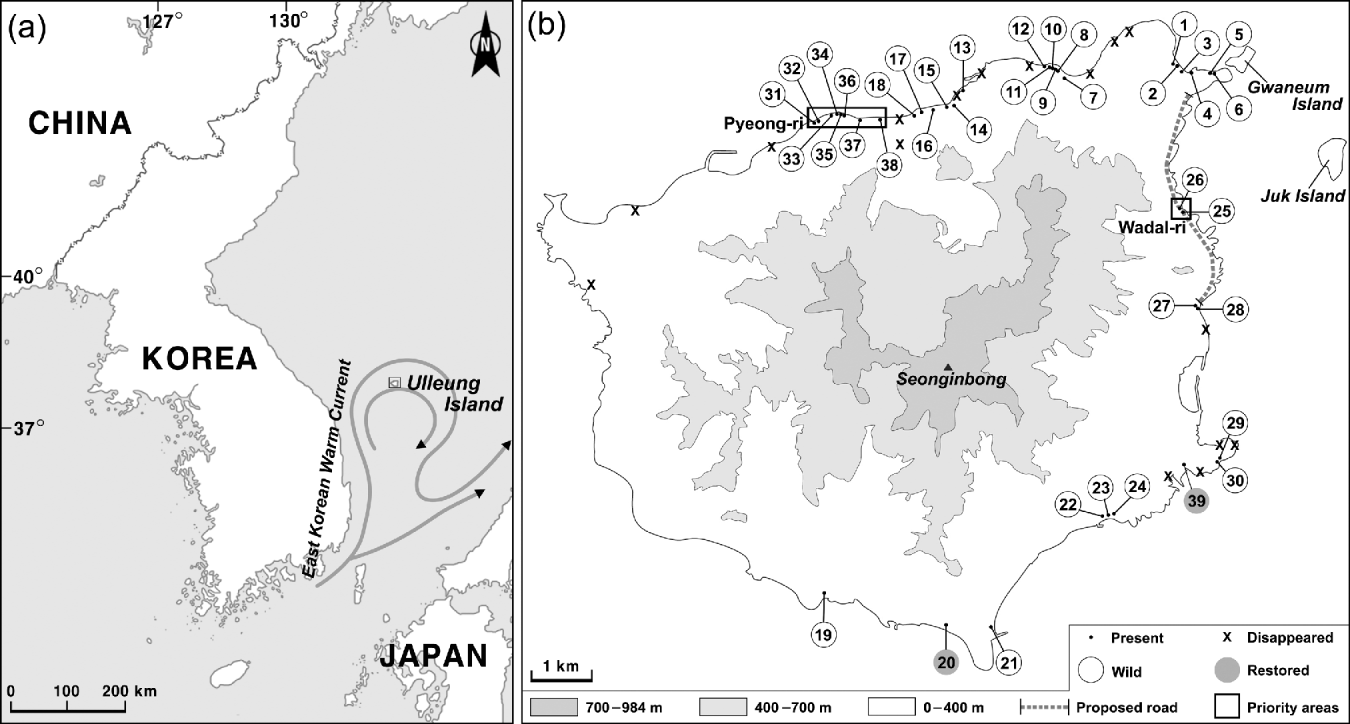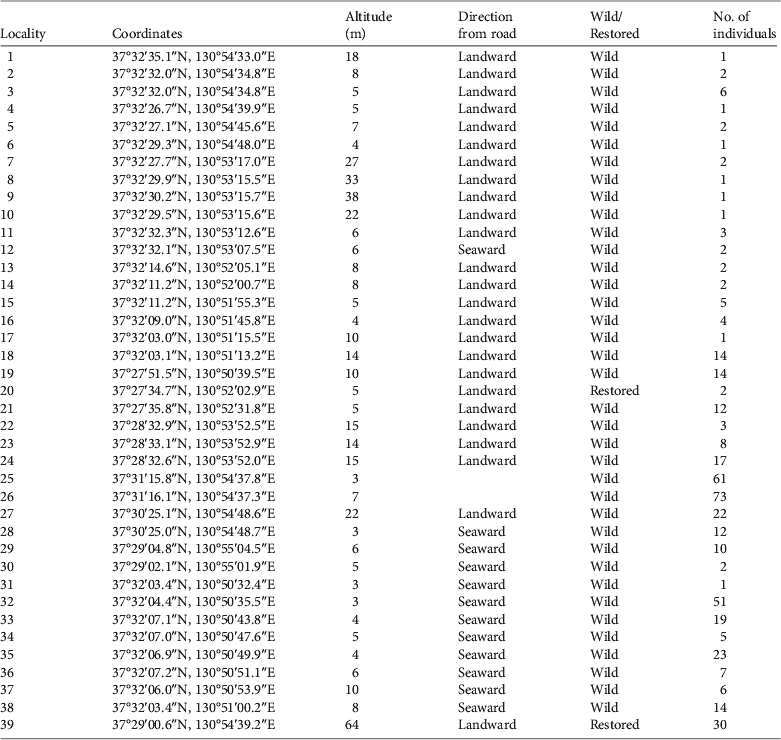The 73 km2 Ulleung Island in the East Sea lies c. 150 km from the Republic of Korea mainland (Fig. 1a). The plant Scrophularia takesimensis Nakai, endemic to Ulleung Island and two adjacent islets, Juk and Gwaneum (Kim & Kang, Reference Kim and Kang2010), is categorized as Critically Endangered in the Rare Plant Data Book of Korea (Lee, Reference Lee2009). Such narrow endemics are susceptible to extinction for several reasons, in particular the destruction of their habitat (Lande, Reference Lande1988; Schemske et al., Reference Schemske, Husband, Ruchelhaus, Goodwillie, Parker and Bishop1994; Bizoux et al., Reference Bizoux, Brevers, Meets, Graitson and Mahy2004; Ali & Qaiser, Reference Ali and Qaiser2011; Fenu et al., Reference Fenu, Mattana and Bacchetta2011; Martinell et al., Reference Martinell, López-Pujol, Blanché, Molero and Sàez2011), and a single small-scale disturbance could trigger extinction (Bernardos et al., Reference Bernardos, Amado and Amich2006). The goals of this study were to (1) provide an update on the occurrence of this species on Ulleung Island, (2) reassess its conservation status, and (3) use this information to propose priority areas for conservation of the species.

Fig. 1 (a) Location of Ulleung Island off the Korean mainland, with the direction of flow of the East Korean Warm Current, and (b) distribution of the subpopulations (1–39; Table 1) of Scrophularia takesimensis located on Ulleung Island in 2011.
We reviewed information on the distribution of S. takesimensis available in Ahn (Reference Ahn2005), Lim et al. (Reference Lim, Na, Lee, Cho and Shin2008), Han et al. (Reference Han, Kim, Suh, Kwon and Song2010) and Kim & Kang (Reference Kim and Kang2010). Kim & Kang (Reference Kim and Kang2010) also provided information about this species on the two adjacent islets (Fig. 1b) but, as the populations there comprise only c. 0.6% of the total known individuals (Kim & Kang, Reference Kim and Kang2010), we did not examine them further. S. takesimensis usually exhibits a clumped structure, with the clumps formed by vegetative propagation of the root. We therefore counted individuals based on their clump; shoots composing a clump were considered an individual. During 2–9 August 2011 we examined all localities on Ulleung Island from which S. takesimensis had been reported, and other potentially suitable coastal localities. Habitats were divided into subpopulations based on the spatial separation of individuals (Lim et al., Reference Lim, Na, Lee, Cho and Shin2008), and locations were recorded with a global positioning system. All individuals within each subpopulation were counted.
We found 39 locations with S. takesimensis (Table 1; Fig. 1b) and consider each to be a subpopulation. These subpopulations have a highly fragmented distribution along the northern (67%), eastern (10%) and southern coasts (23%) of Ulleung Island at altitudes of 2–33 m. At two localities (20 and 39) S. takesimensis was restored by reintroduction of seedlings in 2005 (by Key-chungsan Botanical Garden) and 2006 (by Korea National Arboretum), respectively. Nearly all examined sites (95%) were within 5 m of the coastal road, on either the seaward or landward sides (Plate 1). Immature individuals were usually growing in a sandy substrate on the seaward side. All subpopulations were in previously known sites and we did not record any new locations. Of the previously known subpopulations (Ahn, Reference Ahn2005; Lim et al., Reference Lim, Na, Lee, Cho and Shin2008; Han et al., Reference Han, Kim, Suh, Kwon and Song2010) we were unable to locate 16 (29%; Fig. 1b) and conclude that the number of subpopulations is decreasing.

Plate 1 Habiats of Scrophularia takesimensis (circled) to the (a) landward and (b) seaward side of coastal roads.
Table 1 Locality records and details of the 39 subpopulations of Scrophularia takesimensis recorded in 2011 on Ulleung Island. The locations of the numbered subpopulations are indicated in Fig. 1b.

In the 39 extant subpopulations we counted a total of 443 individuals, with subpopulations of 1–73 individuals (Table 1). The highest number of individuals was recorded in subpopulation 26, which does not lie close to a road. Most subpopulations (90%) contained < 30 individuals and eight subpopulations (21%) contained only one individual. The number of shoots per individual was 1–22 (mean=4.2; n=100), and the total number of shoots was estimated to be c. 1,860. The number of fruits per reproductive shoot was 56–718 (mean=200; n=30); almost all individuals fruited normally, producing capsules. The mean number of seeds produced per individual was estimated to be c. 110,000 (n=30) and we conclude that population viability is not limited by seed output. However, only a small proportion of the viable seeds germinate because of the harsh coastal habitat in which S. takesimensis grows (Kang et al., Reference Kang, Choi, Ahn, Kim, Chon and Yun2009).
Dispersal by water is common for plant species typical of wetland and coastal areas (Cadée, Reference Cadée2005). We observed dried branches of S. takesimensis, without roots and leaves, in some coastal locations, with fruits and, in some cases, with seeds. Sections of the dried branches have a sponge-like cortex that enables the branches to break and float. Broken branches of S. takesimensis may thus be carried by the sea and their seeds subsequently dispersed by water, and by wind upon reaching land. S. takesimensis may have extended its range from the north coast to the eastern and southern coasts by means of the East Korean Warm Current (Fig. 1). This could explain the appearance of S. takesimensis on Juk and Gwaneum Islands.
The construction of coastal roads and small harbours, and subsequent habitat loss, is the greatest threat to S. takesimensis (Lim et al., Reference Lim, Na, Lee, Cho and Shin2008). Since construction of coastal roads began in 1963, 39.8 km of a planned 44.2 km have been completed. As a result the subpopulations are now on either the landward or seaward side of the coastal roads, resulting in a reduction in genetic diversity (Park et al., Reference Park, Kim and Park2010) and thus decreasing the probability of survival (Schaal et al., Reference Schaal, Leverich, Rogstad, Falk and Holsinger1991; Neel & Ellstrand, Reference Neel and Ellstrand2001). Considering that putative seed dispersal is by the sea, the effect of the roads is probably more severe on the landward subpopulations (Cassel & Tammaru, Reference Cassel and Tammaru2003), and most of the subpopulations with only one individual occur on this side of the road (Table 1).
For the long-term conservation of S. takesimensis its population size needs to be larger (Park et al., Reference Park, Kim and Park2010) and in situ measures such as protection and restoration of natural habitats will be the most effective methods (Lande, Reference Lande1988). Key-chungsan Botanical Garden planted c. 2,000 seedlings of S. takesimensis on the landward side of the road of subpopulation 20 in 2005. However, we found only two adult individuals there. In terms of the importance of connectivity among the remaining subpopulations (Park et al., Reference Park, Kim and Park2010), the seaward localities will be more favourable candidates for in situ conservation.
The conservation strategy for a threatened species usually starts with the identification of the main threats and, subsequently, with the selection of critical habitat (Cultus Sockeye Recovery Team, 2005). Critical habitat is that necessary for the survival or recovery of a threatened species (SARA, 2003). Based on our surveys we propose two priority areas for the conservation of S. takesimensis: the northern (Pyeong-ri) and eastern (Wadal-ri) coast, comprising eight (31–38) and two (25 and 26) wild subpopulations, respectively (Fig. 1b). The subpopulations of these two areas are located on the seaward side of roads (Pyeong-ri) or in coastal areas without roads (Wadal-ri), and harbour 63% of the wild individuals recorded (126 individuals in Pyeong-ri and 134 in Wadal-ri). Because of its inaccessibility Wadal-ri is the only undisturbed site and has a relative abundance of immature individuals. There is a need to halt the planned construction of a coastal road in this area, which could cause irreparable damage to this critical habitat. Forthcoming studies of the genetic structure and variation of all remnant individuals of this species will be essential for further identification of critical individuals and habitats and for planning the conservation of the species' genetic diversity.
In summary, S. takesimensis is highly threatened, with only 443 individuals in 39 known subpopulations, and is restricted to coastal areas. The typical habitat of the species has been greatly reduced by human influence, and in particular by the construction of coastal roads. To conserve this species more effectively we recommend that: (1) the two habitats identified as a priority for conservation should be afforded special protection, (2) habitats to the seaward side of coastal roads are more suitable than habitat on the landward side for in situ conservation, and (3) the presently known subpopulations require continuous protection and monitoring.
Acknowledgements
This research was partly supported by a grant from the Korea Forest Service (S111111L040000) and the Environment Research and Technology Development Fund (S-9-2) of the Ministry of the Environment, Japan.
Biographical sketches
Hyeok Jae Choi previously studied the systematics of the genus Allium. His research interests are currently focused on the conservation genetics of threatened plant species of Korea and Japan. Hyun Do Jang carries out taxonomic research on the genus Scrophularia in Korea. Yuji Isagi is a molecular ecologist and has been leading projects on the conservation of species based on genetic information. Byoung Un Oh is a botanist with an interest in the taxonomy, distribution and conservation of the vascular plants of north-eastern Asia.





